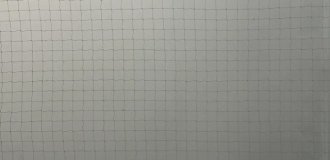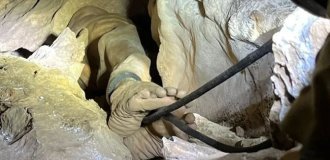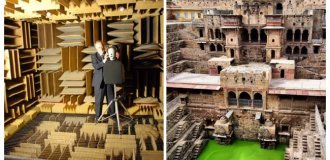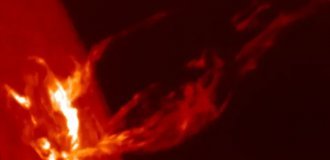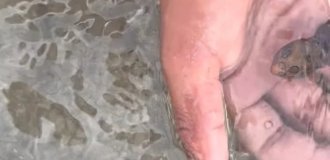In the footsteps of Castaneda or what the author smoked (14 photos)
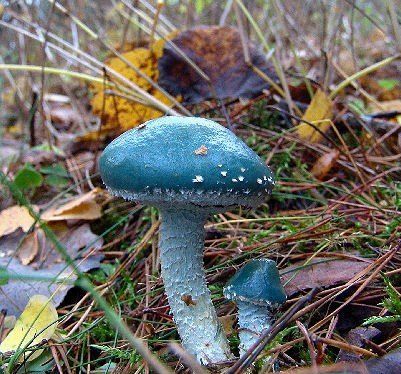
A little bit of history
Currently, the genus Psilocybe includes about 20 species. At the same time, American and Asian species are poorly studied. Species of this genus are cosmopolitan and are widely distributed on almost all continents. Mushrooms of the genus Psilocybe — saprotrophs. They settle on the soil, dead branches and stems of plants, are found on sawdust, many live on sphagnum bogs, peat, and manure. They are found in the forest on forest humus. A characteristic feature of many mushrooms — living in marshy soil. Therefore, they belong to helophytic species.
They have a peculiar use. In some manuscripts of the XVI — XVII centuries, which describes the disappeared culture of the Aztecs, there is a mention of Indian ritual rites, in connection with which they used mushrooms that cause hallucinations. The hallucinogenic properties of some mushrooms were known to Maya priests in ancient Mexico, who used them in religious ceremonies. These mushrooms have been consumed in Central America for a very long time. The Indians consider them divine mushrooms. Even stone images of mushrooms, revered by the Indians as deities, have been found.
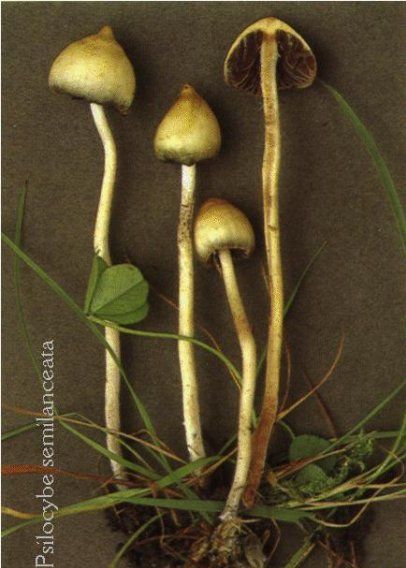
What is it?
Psilocybin and psilocin contain mainly psilocybin mushrooms of the Psilocybe and Panaeolus species. (There are several other types of hallucinogenic mushrooms containing these alkaloids, belonging to the genera Inocybe, Conocybe, Gymnopilius, Psatyrella, but their role is relatively small.) Psilocybin mushrooms grow almost all over the world: in Europe, in the Americas, Australia, Oceania, Africa etc. Their species vary from place to place, but it is practically difficult to find a place where some species of fungi such as Psilocybe Cubensis or Panaeolus did not grow at some time, under some conditions. Most likely, not only knowledge about their varieties is growing, but also the area of their distribution. Hallucinogenic mushrooms – 100% saprophytes, that is, they live due to the decomposition of organic matter (unlike other fungi - parasitic (living at the expense of the host) or mycorrhizal (forming symbiotic relationships with tree roots). Psilocybin mushrooms well populate "disturbed" biocenoses, that is Roughly speaking, places where there is no longer nature, but not yet asphalt, and there are a lot of them on Earth.For some reason, hallucinogenic mushrooms like to grow close to humans; they are almost never found in complete wilderness.Their main habitat is wet meadows and clearings; many psilocybin mushrooms prefer cow or horse dung in these meadows. There are many types of hallucinogenic mushrooms, and they are actually quite diverse both in appearance and in their preferences. Many of the hallucinogenic mushrooms turn blue when broken , although this sign cannot be considered either necessary or sufficient for definition and even more so for use.The chemical nature of this bluing is unknown, although most likely related to the reaction of psilocin in the air. Psilocybin mushrooms differ in psilocin and psilocybin content; a large and complete table of this information is published by Paul Stamets in Psilocybine Mushrooms of the World. Such information regarding each specific type of mushroom is practically important (how much to eat; how to store), but it is still not enough accumulated. There are very "strong" mushrooms, such as Psilocybe cyanescens, which grows in the northwestern United States, in the humid forests of Washington state; there are much less active ones; for many species, such data are still not established. Almost every year new species of Psilocybe and others are described, mainly from little explored regions of the Earth; but famous for its "strength" “Astoria”, for example, has also been described very recently, although it grows in the USA. Gastón Guzmán, one of their main taxonomists, says that even in his Mexico, where he studies their half-life, undescribed mushroom species are still – a lot.

Psilocybe semilanceata (Fr.) P. Kumm. 1871; other Russian names — sharp conical bald head, «cap of freedom», «veselushka») — species of fungus of the strophariaceae family. It contains psilocybin and psilocin, which have psychoactive properties, therefore it is classified as an inedible hallucinogenic mushroom.
Agaric mushroom. The hat measures from 5 to 25 mm, its height is one and a half times the width, the shape is from semicircular to conical, at the end there is a small tubercle, the edge can be rolled up, the surface is smooth, finely fleshy. The mucous cap skin is removed especially easily in young specimens. Beige in dry conditions to olive-tinged brown in moist conditions, sometimes streaked. The flesh turns blue when damaged and dried. The leg is lighter than the cap, strong, flexible, elastic, smooth or with scales at the beginning, without a border. The plates are dark, sometimes black, less often — grey.
Prefers to grow among grass in glades fertilized by cattle, in damp places, on hummocks, on irrigated surfaces. The main time of growth falls on the end of August — mid-January, mostly in September and November.
The content of substances in mushrooms can vary depending on the conditions in which they grew, the individual susceptibility of people to these substances also varies from person to person, so we can only say that several dozen mushrooms can have a significant effect on the human psyche. Mushrooms are eaten raw, dried (~35 °C; in this case, all psilocin is lost, and the “strength” of the mushrooms drops somewhat) or frozen. They are not smoked or poured with boiling water because psilocybin decomposes from high temperature. However, to reduce the load on the stomach and liver during the digestion of chitin, dry mushrooms are brewed in hot water (no more than 80 ° C), infused for about 20 minutes, and the decoction is drunk, into which almost all psilocybin passes. They also make "tincture" mushrooms: stand in honey for several months, after which psilocybin passes into honey and it becomes bluish in color.
Mushrooms last approximately 4—7 hours. The onset of action is observed 20-45 minutes after ingestion (mushroom decoction can begin to act as early as 10 minutes), the increase to a peak takes about 1 hour, and the peak itself lasts 2-3 hours, followed by a decline within 1-2 hours . There may be a partial or complete loss of reason (madness) due to a strong change in consciousness, which may be irreversible or the help of professional psychiatrists will be required to get out of this state. After the end of the action of the fungi, an aftereffect may remain for about a few days, sometimes called "afterglow"; (from English afterglow), which can be expressed by a general state of peace and a slight increase in perception, or the onset of depression with the search for the meaning of existence.
The psychedelic effect of mushrooms is also called a trip. Mushroom users describe their action as more "softer" than compared to synthetic phenethylamines, and more "natural" than the action of LSD.
Psilocybe montana

Collect time: End of July — beginning of December.
Location: Among moss, lichen and ferns, on sandy soils in forests.
Hat
Dimensions: diameter 6 — 25 mm, half the height of the width.
Shape: semicircular to elongated semicircle, breast-like, often with a distinct nipple.
Colour: Gray-brown when dry, brown with a hint of ocher when damp.
Surface: Smooth, finely fleshy, with notches from the edge outward to a half radius.
Leg
Dimensions: 25 — 75 mm high, 3 mm in diameter.
Shape: mostly uniformly strong, curved, thickened at the base.
Color: brown, slightly lighter towards the hat.
Surface: smooth without ring (veil/border).
Spore layer
Color: first light, later dark brown.
Location: far apart, connected to the stalk (adnat), spore-bearing layer almost triangular.
ACTIVITY: moderate to medium, always less than Psilocybe semilanceata.
Stropharia coprophila (poop's bald head)
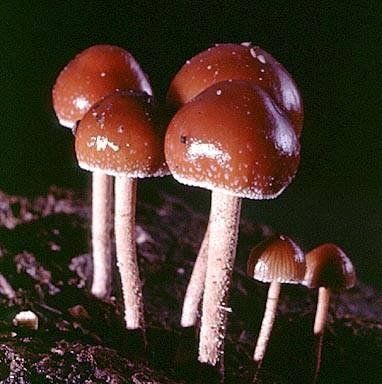
Pick time: the rarest psilocybes (?), mid-August — mid-December.
Location: found both individually and in large numbers. Almost always right on the shit (coprophil. ia = shit loving).
Hat
Dimensions: 6 — 25 mm diameter.
Shape: semicircular.
Colour: light to dark brown, shiny when damp.
Surface: sticky or dry, slightly rough around the edges, especially when young.
Rim: white, shapeless border (remnants of the inner shell — Velum partiale), keeps ripeness for a long time.
Leg
Dimensions: 25 — 75 mm high, 3 mm diameter.
Shape: uniformly thick. Slight thickening at the base.
Color: yellow-brown, slightly lighter than the hat.
Surface: dry, smooth, hard and brittle, with little remaining skins shell or no shell at all.
Spore layer
Color: taupe with white margins, dark red to almost black with age.
Position: almost triangular, adnat.
ACTIVITY: moderate to medium, less than Psilocybe semilanceata.
Stropharia aeruginosa (verdigris troishling)

Location: often in large numbers along roadsides in forests.
Hat
Dimensions: dimatr 30 — 80 mm.
Shape: rounded or convex, distinct
Colour: copper oxide color with a dash of green (like verdigris), later paler to ocher. the ippel is mostly brownish in color.
Surface: slippery skin with whitish scales. Removed. The pulp is whitish, odorless and tasteless.
Leg
Shape: straight, concave.
Color: bluish green, small ring (Velum partiale remnant) with whitish scales.
Spore layer
Color: whitish, later grey-violet.
Location: attached to the stem (adnat).
Spores: purplish brown, 7-9 x 4-5 msm, elliptical in shape.
ACTIVITY: none or very little.
Stropharia semiglobata (semicircular troishling)
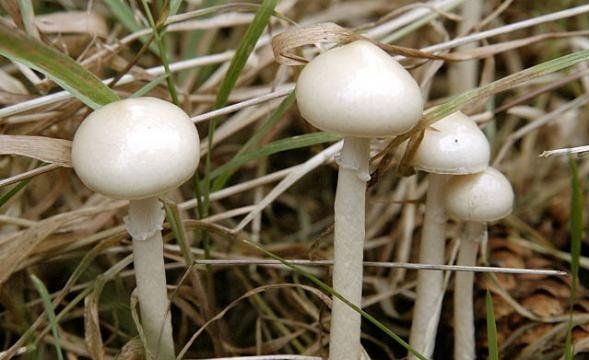
Time of collection: from spring to autumn.
Location: on manure.
Hat
Dimensions: diameter up to 30 mm.
Colour: ocher to lemon, brilliant when dry.
Leg
Color: pale — yellow.
Shape: tubular.
Surface: Slightly scaly underneath.
Spore layer
Color: gray — olive, later brown — black.
Location: widely fused (adnat).
ACTIVITY: none or very little.
Stropharia merdaria (Psilocybe merdaria) (dung bald patch)

Location: On rotting horse manure and well fertilized soils, in grass, in gardens and fields.
Hat
Dimensions: diameter 8 — 30 mm.
Form: bell, later expanded.
Color: pale ocher when dry, yellowish brown when damp.
Surface: smooth, whitish, soft on
The edge: and the edge at a young age remains the remains of the shell.
Leg
Dimensions: long.
Shape: thin, fine-fibered, often elongated at the base in the form of a spindle or root.
Color: light — yellowish.
Spore-bearing layer
Color: chocolate — brown, in old age with black spots, whitish along the edges.
Location: widely fused (adnat), compressed.
Spores: purple — black, 10-13 x 7-10 mm, elliptical, smooth, with germinal columns.
ACTIVITY: none or very little.
Stropharia cubensis
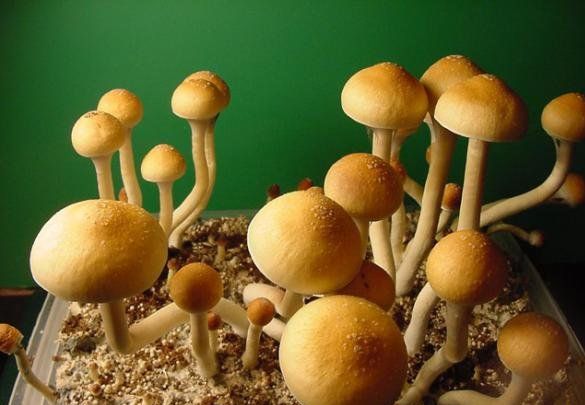
Origin: Southern US, Central America, subtropical regions, on manure. We grow artificially at home on a culture substrate.
Hat
Dimensions: 10 — 80 mm dia.
Color: pale — yellowish, brownish in old age.
Shape: first cone-shaped, then bell-shaped in old age, convex at the end (the end is bent upwards).
Surface: dirty, smooth. The flesh is firm, whitish, turns blue when damaged.
Leg
Dimensions: 40 — 150 mm long, 4 — 10 mm in diameter.
Shape: uniformly thick, stronger at the base.
Colour: white, turns blue when damaged, dry, smooth, white ring (remnants of Velum partiale).
Spore-bearing layer
Color: gray to grey-violet, whitish edges.
Spores: purple-brown, 10-17 x 7-10 mm, elliptical to oval, thick-walled.
ACTIVITY: Uniform. Very high.

Collect time: August — end of December.
Location: singly or in small groups, on fallen trees, logs and in wet grass.
Hat
Dimensions: 25-50 mm dia.
Form: very young — cone-shaped, then in the form of a bell or breast, at the end flat or concave upwards.
Color: yellow if dry, chestnut if wet. Blue spots on damaged areas.
Surface: smooth and firm when dry, slightly tacky when damp, brittle with age.
Brim: After the hat is already flat, the brim grows further and curls.
Leg
Dimensions: 25-100 mm high, 3 — 6 mm in diameter.
Shape: uniformly thick and slightly bent, noticeable thickening in the lower quarter, often remnants of the skin of the shell.
Color: almost white above, amber below, light blue when dry.
Surface: fragile with silky fibers.
Spore layer
Color: first cinnamon, then reddish brown with black-purple spots (from ripe spores that fall).
Location: not tight, adnat.
ACTIVITY: very high.
Panaeolus campanulatus/sphinctrinus (bell bugger)

Time of collection: April — December.
Location: mostly in groups, sometimes singly, on soil well manured with cow or horse manure, often directly on manure. Distributed in fertile meadows and river valleys, often on or near places where especially tall grass grows (dung, fertile soil).
Hat
Dimensions: 8 — 35 mm diameter, height slightly larger than width.
Shape: first oval, then bell or umbrella, never flat.
Colour: Whitish or gray and silky shiny when dry, tinged reddish brown when wet. Often brownish in the center.
Surface: folded, sometimes torn if dry, silky if damp. Brittle thin pulp of gray color without a special smell or taste.
Margin: Hanging down through the spore-bearing layer, first turned inside out, later slowly expanding. a small skin of the shell (Velum partiale) leaves a jagged whitish border on the edge of the cap for a long time.
Leg
Dimensions: 35 — 80 mm high, 2 — 3 mm diameter.
Shape: almost straight, evenly thin, hollow, slightly thickened at the base of the mycelium.
Color: initially reddish, with age the upper part is blackish brown or black due to adhering spores.
Surface: shiny, slightly ribbed, covered with a fluff of small whitish hairs that give the stem a pale, floury appearance.
Spore layer
Color: gray-brown with white edges, speckled purple-black in old age. Sinuat and attached to the leg (adnat).
Location: very dense.
Spores: black, 14-18 x 9-12 mm, lemon-colored, thick-walled.
ACTIVITY: slight to moderate.
Panaeolina foenisecii (hay dung beetle)
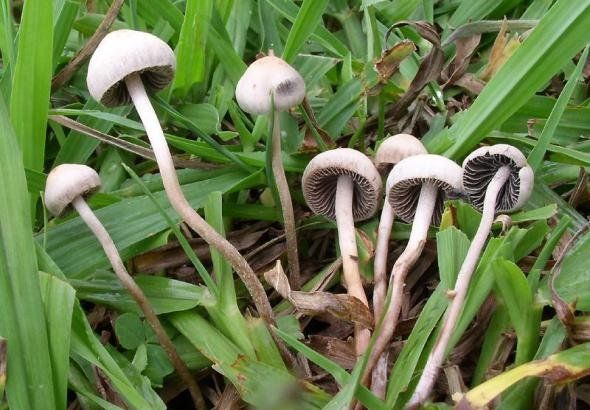
Pick time: grows from spring to early December, best in September and October.
Location: singly or in groups in short grass. and lawns, fields, river valleys or fertile pastures.
Hat
Dimensions: 8 — 25 mm diameter, 8 — 16 mm high.
Shape: first semi-circular to broad conical, then bell-shaped, many umbrella-shaped at the end, but never flat.
Colour: Beige yellow to cinnamon, with a light brown surface, shiny when dry. When wet, they become dark red-brown.
Surface: soft with grooves when damp, torn and scaly when dry, especially in older specimens.
Leg
Dimensions: 20 — 80 mm high, 3 — 4 mm dia.
Shape: straight and uniform, sometimes slightly flat.
Color: light, with a reddish tint, when dry, becomes brown when wet. the cap is always lighter than the cap, especially in the upper part and in young specimens, brownish at the foot.
Surface: smooth, hollow, brittle, brittle. No ring.
Spore layer
Colour: Pale brown and mottled (does not produce spores everywhere), with white margins, darkens to black flecks (when spores are ripe and shed), much browner than Panaeolus species (bell-shaped dung beetles).
Location: relatively close to each other, widely fused with the stem, adnat.
ACTIVITY: slight to moderate.
Amanita pantherina (leopard mushroom)
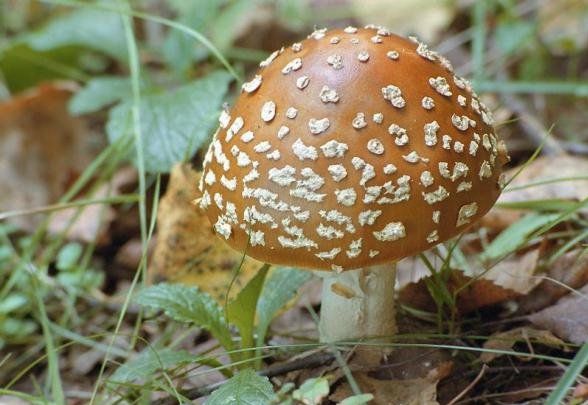
It is less common and richer in biologically active substances than Amanita muscaria (debatable in the case of European panther mushrooms, which allegedly contain neither ibotenic acid, nor muscimol, nor muscazone, instead — pantherine similar to ibotenic acid.)</p >
It can be easily distinguished from Amanita muscaria: smaller sizes, mushrooms with a hat more than 120 mm indiameter is rare. The cap is dark brown when young, mottled with remnants of Velum universale, becoming coffee-brown in old age. The hollow stalk is skin-colored and not white, and the scales form complete rings around the stalk (instead of the interrupted rings in A. muscaria). Above the round tuber there are from one to two low, often obliquely arranged rings.
ACTIVITY: Very high, but also very poisonous. Caution!
Amanita muscaria (red fly agaric)
Pick time: end of July (wet summer) — beginning of December, most often in September.
Location: singly or in scattered groups under birches, beeches, hazel, pines and larches. Usually on infertile soils.
Hat
Dimensions: 30 — 200 mm diameter, 30 — 50 mm
Shape: almost round in a young mushroom, then from conical to umbrella-shaped, in old age from flat to bent upwards (concave?).
Color: from dark red to orange in a young mushroom, later orange-yellow, usually on the skin of the cap (the remains of Velum universale) there are whitish protrusions with a diameter of 1.5 — 12 mm.
Surface: firm and fleshy. and the surfaces are usually described spots, remnants of the outer shell (Velum universale), which can be washed away by heavy rain. The flesh is white, yellow under the skin of the cap, odorless, weak taste of potatoes. Often with grooves, up to 6 — 18 mm from the edge.
Leg
Dimensions: 70 — 250 mm high, 18 — 30 mm diameter.
Shape: straight and evenly thick, thick tuber at the base, with remnants of the outer shell (Velum universale), on the upper third a ring (remnants of Velum partiale).
Color: brilliant white with yellow spots.
Surface: soft and scaly, especially near the base, where the remnants of Velum universale hang in continuous rings on the stem. The velum partiale remains hanging like a border on the top of the leg.
Spore layer
Color: white with cream edges.
Location: very tight, close together and loose, wide.
ACTIVITY: Very high, but also poisonous. Caution!
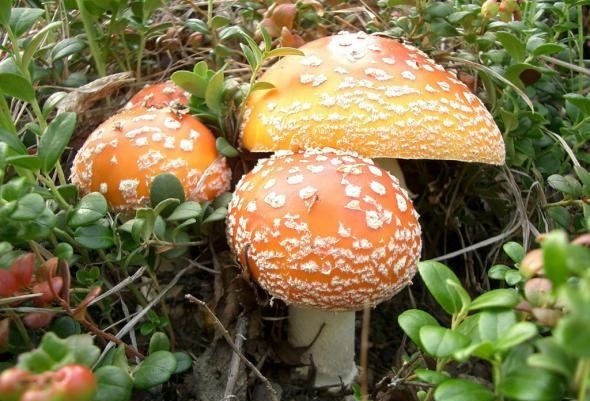
Pick time: end of July (wet summer) — beginning of December, most often in September.
Location: singly or in scattered groups under birches, beeches, hazel, pines and larches. Usually on infertile soils.
Hat
Dimensions: 30 — 200 mm diameter, 30 — 50 mm
Shape: almost round in a young mushroom, then from conical to umbrella-shaped, in old age from flat to bent upwards (concave?).
Color: from dark red to orange in a young mushroom, later orange-yellow, usually on the skin of the cap (the remains of Velum universale) there are whitish protrusions with a diameter of 1.5 — 12 mm.
Surface: firm and fleshy. and the surfaces are usually described spots, remnants of the outer shell (Velum universale), which can be washed away by heavy rain. The flesh is white, yellow under the skin of the cap, odorless, weak taste of potatoes. Often with grooves, up to 6 — 18 mm from the edge.
Leg
Dimensions: 70 — 250 mm high, 18 — 30 mm diameter.
Shape: straight and evenly thick, thick tuber at the base, with remnants of the outer shell (Velum universale), on the upper third a ring (remnants of Velum partiale).
Color: brilliant white with yellow spots.
Surface: soft and scaly, especially near the base, where the remnants of Velum universale hang in continuous rings on the stem. The velum partiale remains hanging like a border on the top of the leg.
Spore layer
Color: white with cream edges.
Location: very tight, close together and loose, wide.
ACTIVITY: Very high, but also poisonous. Caution!


